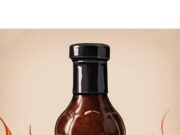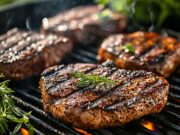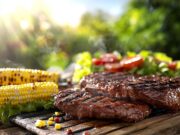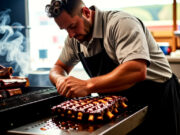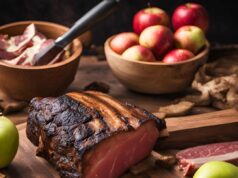When it comes to grilling, nothing surpasses the irresistible taste and texture of perfectly seared meats cooked over direct heat. This guide will provide you with comprehensive insights, from selecting the best cuts of meat to understanding essential marinades and seasonings.
You will learn how to set up your grill for optimal results, timing techniques to achieve that mouthwatering char, and common pitfalls to avoid.
Prepare to elevate your grilling skills and impress your friends and family with delicious, expertly grilled dishes.
Key Takeaways:
- Proper preparation, including marinating and seasoning, is key to achieving perfectly seared meats on the grill.
- Timing and techniques are crucial when grilling with direct heat. Knowing when to flip and how to control the heat will result in perfectly cooked meats.
- Avoid common mistakes, such as overcrowding the grill and moving the meat too often, to ensure the best results when grilling with direct heat.
Choosing the Right Meat for Grilling
Choosing the right meat for grilling is essential for achieving optimal flavor and texture. Popular options such as ribeye and T-bone steaks stand out due to their marbling and tenderness.
Understanding the characteristics of different cuts can significantly enhance your grilling experience. For example, ribeye steaks, with their rich intramuscular fat, deliver an indulgent burst of flavor, making them ideal for high-heat grilling. On the other hand, cuts like filet mignon are leaner and provide a tender texture that many appreciate, but they require careful cooking to avoid dryness. The amount of marbling is a crucial factor, as it not only contributes to juiciness but also enhances the overall taste during cooking.

When selecting a steak, it is vital to consider your grilling techniques—whether you prefer direct or indirect heat—as well as the desired cooking temperatures. Matching these elements to the specific cut will ensure that each bite is as satisfying as possible.
Preparation: Marinating and Seasoning
Preparation for grilling requires careful attention to marinating and seasoning your meat to enhance its flavor and tenderness. Options can range from a rich balsamic reduction to a vibrant chimichurri sauce.
This essential step not only infuses the meat with delightful flavors but also breaks down proteins, resulting in a juicier, more tender steak. For a straightforward marinade, consider combining olive oil, garlic, fresh herbs, and a splash of citrus juice; this mixture not only complements the meat but also adds a refreshing zest.
In terms of seasoning blends, a combination of salt, black pepper, paprika, and garlic powder can significantly elevate the natural taste of the steak. Additionally, incorporating fruits and vegetables, such as grilled peaches or zucchini, can enhance both the presentation and nutritional value of your meal, transforming it into a vibrant feast that appeals to the senses.
Setting Up Your Grill
Properly setting up your grill is essential for successful direct heat grilling, whether you opt for a charcoal grill or a gas grill. This ensures optimal heat distribution and cooking efficiency.
A well-prepared grill not only enhances flavor but also reduces cooking time and guarantees that your food is cooked thoroughly.
For charcoal grills, start by arranging your coals into pyramids to create hot spots for direct grilling, while leaving one side clear for indirect cooking. Conversely, gas grills offer a simpler setup; just ignite the burners on one side for direct heat while keeping the other side off for indirect heat.
Always prioritize safety by keeping flammable materials away from the grill and monitoring it closely. You can easily check the grill temperature with a grill thermometer placed on the cooking grates, ensuring an ideal cooking environment for your meals.
The Grilling Process: Timing and Techniques
The grilling process requires precision, timing, and a thorough understanding of grilling techniques to achieve that perfect, sizzling steak that is full of flavor and juices.
To begin, preheating the grill is essential; it sets the stage for even cooking and helps create those attractive sear marks. As the grill heats up, this is an excellent time for you to prepare the meat by seasoning it to enhance its natural flavors.
Once the grill reaches the ideal temperature, typically between 450°F and 500°F for steaks, it is important to monitor cooking temperatures closely. Utilizing a meat thermometer will help ensure that your steak is cooked to your desired doneness, whether that be rare, medium, or well-done.
You can employ various grilling techniques, such as direct grilling for a quick, high-heat cook or indirect grilling for more delicate items. Throughout this process, maintaining patience is crucial; allowing the meat to rest after grilling will ensure that the juices settle, resulting in a more tender and flavorful bite.
Common Mistakes to Avoid
Avoiding common mistakes is essential to mastering direct heat grilling, as missteps can lead to overcooked or underwhelming meats, negatively impacting the overall dining experience.
One prevalent error is improper temperature management, resulting in meats that are unevenly cooked and lacking the desired sear. It is crucial to ensure the grill’s temperature is properly regulated; utilizing a thermometer can help achieve the ideal heat.
Many grillers struggle with patience, feeling the urge to constantly flip the meat. Allowing sufficient time for a good char can significantly enhance flavors. Additionally, poor meat selection is often overlooked—choosing cuts that are too lean can result in dryness. Opting for marbled cuts or those with a bit more fat can yield juicier results, ultimately elevating the meal.
Additional Tips for Perfectly Seared Meats
To achieve perfectly seared meats, it is essential for you to understand various grilling techniques and tips that enhance flavor and improve your overall dining experience.
Taking the time to let the meat rest after grilling is just as crucial as the grilling process itself, allowing the juices to redistribute for maximum tenderness. Checking for doneness with a reliable meat thermometer ensures that your meats are cooked accurately and safely. Aim for internal temperatures that meet food safety standards while still achieving the desired doneness.
Presentation also plays a vital role; a beautifully arranged platter with vibrant sides can significantly elevate the experience. By integrating these careful details, you can truly impress your guests and create memorable meals that are not only delicious but also visually inviting.
Frequently Asked Questions
What is direct heat grilling and why is it important for seared meats?
Direct heat grilling is a cooking method where food is placed directly over the heat source, such as a flame or hot coals. It is important for seared meats because the high heat allows for a caramelized crust on the outside while keeping the inside juicy and tender.
What are some tips for achieving perfectly seared meats on a direct heat grill?
First, make sure your grill is preheated to a high temperature. Next, pat your meat dry and season it before placing it on the grill. Avoid moving the meat too much while it cooks to ensure a nice crust forms. Finally, use a meat thermometer to ensure it reaches the desired level of doneness.
How can I prevent my meat from sticking to the grill?
To prevent sticking, make sure your grill grates are clean and well-oiled before cooking. Also, avoid pressing down on the meat while it cooks, as this can cause it to stick. If the meat does stick, gently loosen it with a spatula.
Can I use direct heat grilling for all types of meat?
Yes, direct heat grilling is suitable for most types of meat, including steaks, chicken, pork, and seafood. However, thicker cuts of meat may benefit from a combination of direct and indirect heat to ensure they cook evenly.
Do I need to marinate my meat before direct heat grilling?
While marinating can add flavor to meats, it is not necessary for achieving a perfect sear. A simple seasoning of salt and pepper can be enough to enhance the natural flavors of the meat.
Are there any safety precautions I should take when using a direct heat grill?
Always make sure to use a meat thermometer to ensure your meat reaches a safe internal temperature. Also, keep a spray bottle of water nearby in case of flare-ups, and never leave your grill unattended while in use.








